How to create and present a root cause analysis (RCA)?

Root Cause Analysis (RCA) is a systematic approach designed to describe WHAT happened during an incident, determine HOW it happened, and understand WHY it happened. By identifying the underlying reasons for a failure, investigators can implement effective preventive measures. RCA employs a variety of tools and techniques to uncover the primary causes of problems, aiming to eliminate these root causes to prevent recurrence.
Initially developed by Toyota founder Sakichi Toyoda to improve auto manufacturing efficiency, RCA has become a key component in the international Total Quality Management (TQM) movement, corporate process improvement initiatives, and quality control efforts. It is widely used in business, manufacturing, and engineering sectors to foster continuous improvement.
The core philosophy of RCA is that addressing the immediate, obvious problem provides only a temporary fix. To fully eradicate a problem, one must delve into the chain of causative factors. RCA follows this chain of causes and effects to pinpoint the origin of the issue. By comprehensively investigating and analyzing adverse events or near-misses, organizations can take corrective actions that prevent future occurrences rather than merely treating symptoms.
Is RCA really that important?
Yes, of course it is. Imagine a scenario in a manufacturing plant where a machine repeatedly breaks down. A simple solution might be to keep repairing the machine or replace faulty parts when they fail. However, this approach only addresses the symptoms, not the actual cause of the breakdowns. Through RCA, the company could identify a deeper issue, such as inadequate maintenance protocols or operator error, and rectify these underlying problems, leading to more durable solutions.
RCA is critical not only because it helps to prevent future problems but also because it can lead to improvements in efficiency, safety, and quality control. It provides a scientific approach to problem-solving, which, when properly executed, adds significant value to any operational process.
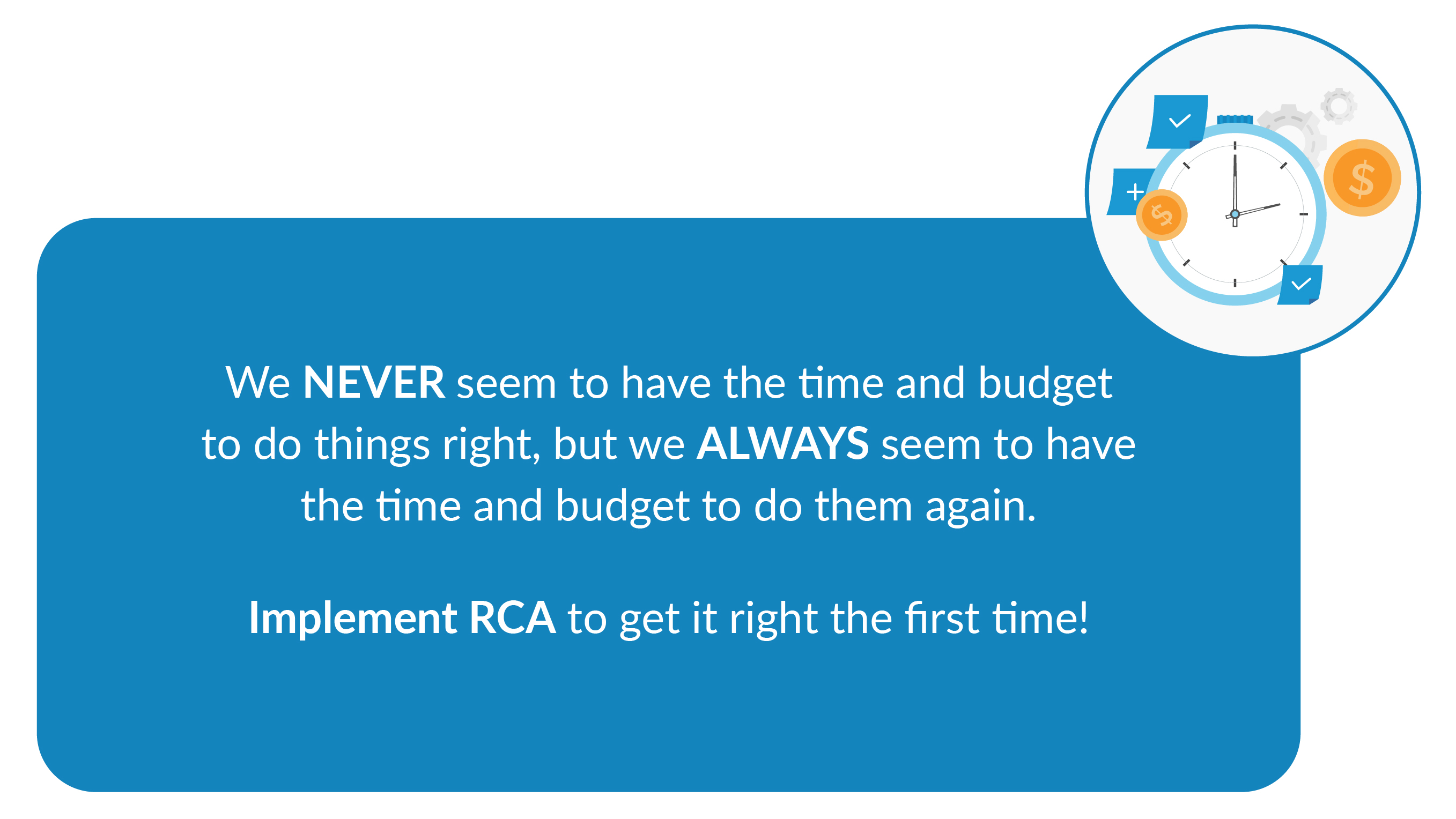
When to perform a root cause analysis (RCA)?
Root cause analysis is not necessary for every small hiccup or minor issue that occurs within a process or system. Typically, RCA is reserved for more significant problems where the solution is not immediately obvious or where the issue has wide-ranging impacts. Here are a few scenarios where RCA is particularly useful:
- Repeated failures: When the same problem occurs repeatedly despite having been fixed multiple times.
- Systemic issues: When the issue is not isolated but affects different parts of the system.
- Major breakdowns: When a severe problem occurs, leading to significant operational downtime or financial loss.
- Safety incidents: Whenever a safety issue occurs, regardless of whether it caused an injury, to prevent future risks.
- Customer complaints: High volume or severe customer complaints can trigger RCA to improve product quality or service delivery.
The most effective root cause analysis methodologies
There are several methodologies available for conducting RCA, each suited to different types of problems and industries. Let's explore some of the most effective RCA methodologies, each designed for specific types of problems and organizational needs. These methods not only help pinpoint the root causes but also facilitate the implementation of effective solutions.
The 5 'Whys'
The 5 'Whys' method is straightforward and serves as a quick means of identifying a problem's specifics. It involves asking "Why?" repeatedly (usually five times) to peel away the layers of symptoms and reach the core issue.
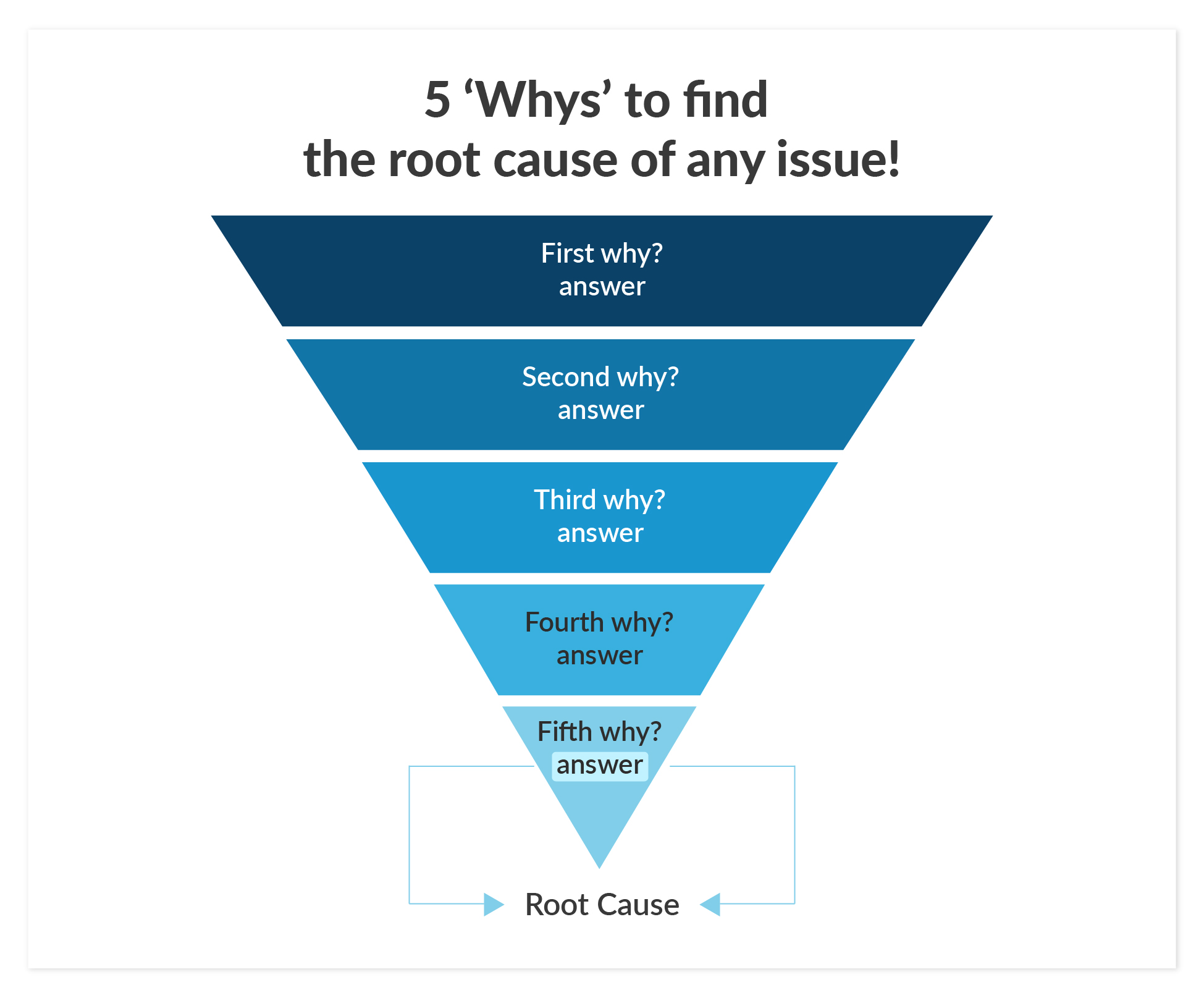
Example: Imagine a company discovers that its website frequently crashes.
- Why did the website crash? - The server was overloaded.
- Why was the server overloaded? - There was a sudden spike in website traffic.
- Why was there a sudden spike in traffic? - A promotional campaign was more successful than anticipated.
- Why did the campaign generate unexpected traffic? - The campaign was not aligned with the capacity projections.
- Why were the capacity projections inaccurate? - The team did not thoroughly analyze the potential impact of the campaign.
In this scenario, the root cause is the lack of thorough impact analysis, and the corrective action would involve better planning and testing for future campaigns.
Fishbone diagram (Ishikawa)
Developed by Kaoru Ishikawa, the fishbone diagram, also known as the cause-and-effect diagram, helps teams visually map out a problem's possible causes to identify potential root causes. The diagram looks like a fish's skeleton, with the problem at the head and the bones representing different categories of root causes (e.g., People, Processes, Technology).
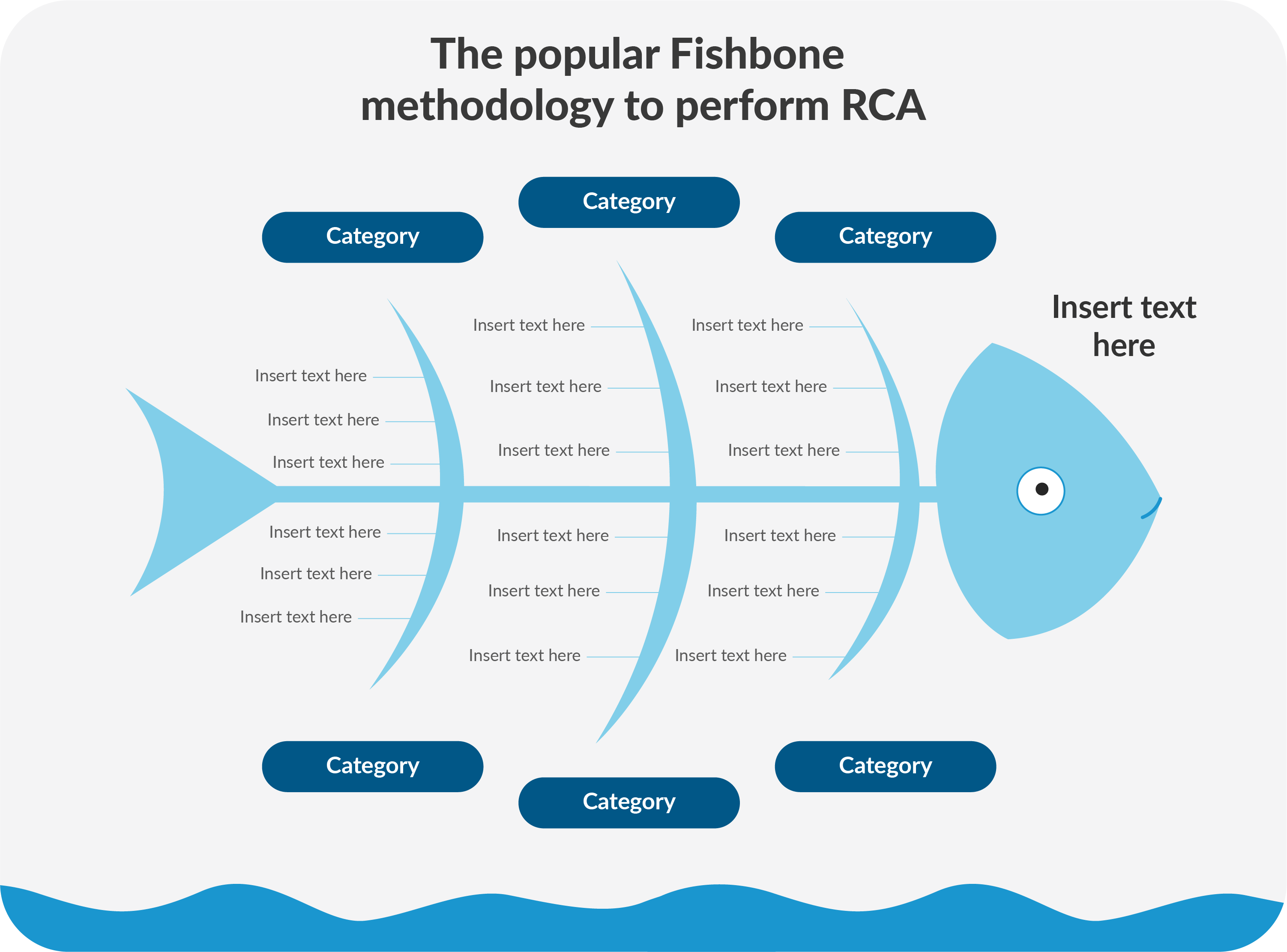
Example: A manufacturing company notices an increase in product defects. By using the fishbone diagram, they can categorize potential causes:
- People: Operator error, lack of training.
- Processes: Inadequate quality control and outdated procedures.
- Technology: Equipment malfunctions and software issues.
- Materials: Substandard raw materials, incorrect specifications.
This method enables a comprehensive analysis covering all operations aspects, helping identify multiple contributors to the problem.
Failure mode and effect analysis (FMEA)
FMEA is a proactive approach that focuses on identifying potential failure modes, their causes, and their effects on the system before they occur. It is particularly useful in product design and manufacturing processes to prevent problems.
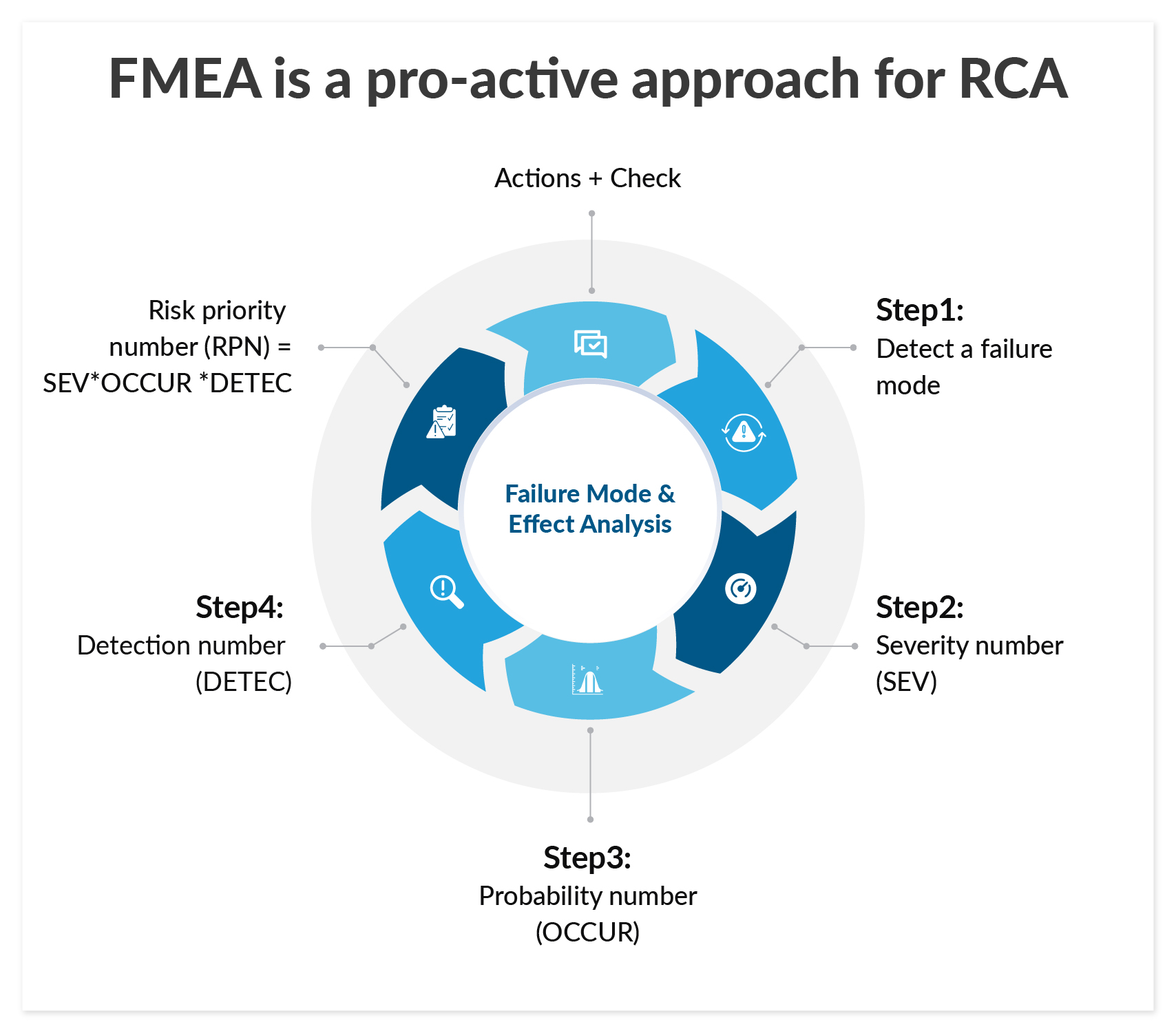
Example: Before launching a new car model, an automotive company uses FMEA to assess various components.
- Component: Brake system.
- Failure mode: Brakes fail to engage.
- Effects: Increased risk of accidents.
- Causes: Poor brake pad quality and incorrect installation.
- Severity, occurrence, detection ratings: Used to prioritize which failures to address based on their impact, likelihood, and detectability.
This analysis helps prioritize issues based on the risk they pose and guide resource allocation to mitigate these risks effectively.
Fault tree analysis (FTA)
FTA is used to analyze the pathways to a root cause or failure state. It uses a tree-like model of the various contributing faults to a particular undesired event, allowing detailed study of the pathways to failure.
Example: An airline wants to understand the risk of engine failure.
- The top event in the tree is "engine failure."
- Contributing events might be "fuel system failure" and "ignition system failure."
- Each of these can be further broken down (e.g., "fuel contamination" and "spark plug failure").
This method is beneficial for complex systems where multiple subsystems can contribute to a failure, helping to identify redundancy and critical points that need safeguarding.

How to implement root cause analysis with ease?
- Define the problem: Clearly describe the issue, including where and when it occurs, its severity, and its impact.
- Collect data: Gather all relevant data about the problem. This can include machine logs, operator inputs, maintenance records, and anything that provides more context to the issue.
- Analyze the data: Using the chosen methodology, analyze the collected data to identify patterns or common factors associated with the problem.
- Identify root causes: Distinguish between contributory and root causes. Focus on those that have the greatest impact.
- Develop corrective actions: Propose solutions that address these root causes. Ensure the solutions are practical and within the organization’s capacity to implement.
- Execute and monitor: Execute the corrective actions and monitor their effectiveness over time. Adjust as necessary.
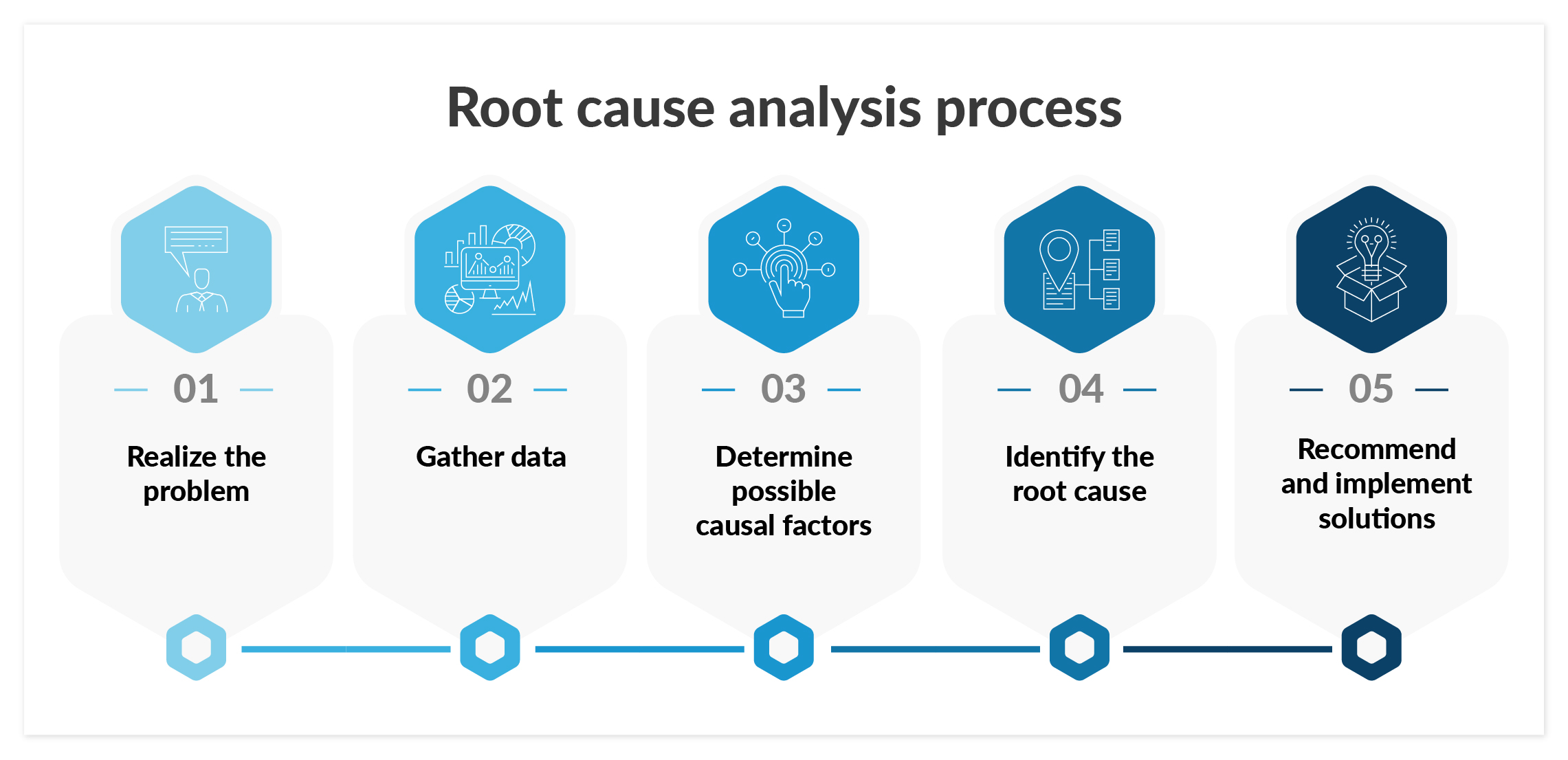
Practical tips while performing RCA
Be thorough, and leave no stone unturned
A successful RCA digs deep. It's not just about finding what appears to be the root cause but ensuring that you've explored every possible factor contributing to the issue. This thoroughness helps prevent the problem from cropping up again unexpectedly.
Pro tip: Imagine you're a detective in a mystery novel. You wouldn’t just look at the obvious suspect; you'd examine all the clues and potential motives to ensure you've captured the full story. Apply this mindset to RCA—treat every problem like a mystery where every detail could be a vital clue.
Involve the right people to harness collective insights
The effectiveness of RCA often hinges on the perspectives included in the process. Include a diverse group from various parts of your organization who interact with the problem area in different ways.
Pro tip: Consider assembling a superhero team with each member bringing a unique power. Just as you wouldn’t tackle a supervillain with just one hero, address complex problems by gathering a team where each member offers a distinct insight or skill set, enhancing the analysis's depth and breadth.
Use appropriate methodology
There's no one-size-fits-all in RCA. Each situation may require different tools from the RCA toolkit, whether it's the 5 Whys, Fishbone Diagram, FMEA, or Fault Tree Analysis.
Pro tip: It’s like being a chef with a spice rack. You wouldn’t use the same spices for every dish. Similarly, select the RCA tool that best 'flavors' your specific problem, enhancing your ability to get to the root cause effectively.
Document everything
Detailed documentation of the RCA process and outcomes is not just about record-keeping; it's about building a knowledge base that your organization can refer back to, learn from, and use for training purposes.
Pro tip: Consider each RCA report as an episode in a documentary series about your organization's journey towards excellence. Each report should tell a compelling story of the problem, the investigation, the findings, and the steps taken to resolve it, providing valuable lessons and insights for current and future team members.
Steps to create and present an impactful presentation on root cause analysis
Creating and presenting a Root Cause Analysis (RCA) involves not just explaining what went wrong but also delivering your findings in a way that is engaging, convincing, and actionable. Here’s how you can create a presentation that not only informs but also impacts your audience.
Step 1 - Gather your RCA findings
Before you even open your presentation software, make sure your findings are comprehensive and well-structured. This includes understanding the initial problem, the RCA method used, the data collected, the root causes identified, and the recommended corrective actions. Organizing your information in a clear and logical order is crucial as it forms the backbone of your presentation.
Step 2 - Select the correct presentation tool
When it comes to presenting Root Cause Analysis (RCA) presentations, choosing the right tool can make a significant difference. While several options exist, understanding the specific benefits of each can help you decide which is most suitable for your needs, especially in enterprise environments where efficiency, brand consistency, and impactful storytelling are crucial.
- Microsoft powerpoint is a traditional favorite, known for its versatility and comprehensive feature set. It's ideal for those who have specific skills in slide design and want to control every aspect of their presentation manually. While PowerPoint offers great flexibility, it requires more time and design expertise to ensure presentations are both visually appealing and aligned with company branding—factors that are critical in a professional setting.
- Google slides shines in scenarios that demand collaboration. It's particularly useful for teams that work remotely, offering real-time collaboration tools that are accessible from anywhere. However, like PowerPoint, it demands a certain level of design savvy from users to create presentations that truly stand out and convey complex information effectively. While it facilitates teamwork, the onus still lies on users to maintain brand consistency and create compelling narratives.
- Prezent emerges as a particularly powerful tool for enterprise-level presentations, where the stakes are high, and the demand for polished, professional output is non-negotiable. Prezent uses advanced AI to automate much of the presentation process, significantly reducing the time and effort required to create impactful presentations. It assists in structuring your RCA findings into a compelling narrative that resonates with both technical and non-technical stakeholders.
Step 3 - Structure an effective presentation
A well-structured presentation helps convey your message clearly and keeps your audience engaged. Here’s a typical structure:
- Introduction:
- Briefly introduce yourself.
- State the purpose of the presentation.
- Provide an overview of the problem.
- Background information:
- Describe when and how the issue was identified.
- Discuss its impact on operations or business.
- RCA methodology and findings:
- Explain the RCA method used.
- Present the key findings with supporting data.
- Use visuals like charts, graphs, and diagrams to illustrate points clearly. Tools like Microsoft Excel, Google Sheets and Prezent can be helpful in storytelling with data.
- Root causes identified:
- Highlight the root causes with evidence.
- Discuss how these were determined and the rationale behind the conclusions.
- Proposed solutions and benefits:
- Outline corrective actions and their expected impact.
- Include a timeline for implementation.
- Show potential benefits using predictive analytics or case studies from similar scenarios.
- Conclusion:
- Summarize the key points.
- Reiterate the importance of addressing the root causes.
- Open the floor for questions or discussion.
- Appendix:
- Provide additional data, detailed analysis, or reference materials that attendees can review later.
Step 4 - Design tips for effective slides
Here are some tips for designing effective slides:
- Keep slides uncluttered: Use bullet points to highlight key facts and keep text minimal. This makes your slides easier to read and understand.
- Use high-quality images and graphics: Visuals can help explain complex information and make your presentation more engaging. Ensure all visuals are high-resolution and relevant.
- Consistent style: Use a consistent font, color scheme, and layout throughout the presentation to keep it professional, cohesive, and 100% brand-compliant.
Here are some basics to designing presentations like a pro.
Step 5 - Rehearse your presentation
Practice public speaking and delivering your presentation several times. This helps you:
- Ensure you can present within the allotted time.
- Familiarize yourself with the flow and transitions of your slides.
- Adjust your talking points to make sure they are clear and concise.
Step 6 - Delivering the presentation
Deliver impactful presentations by following these steps:
- Be confident and clear: Confidence is key in presentation delivery. Speak clearly and at a steady pace that allows your audience to absorb the information. Be mindful not to rush through your points. Natural gestures can help emphasize key findings and make your delivery more engaging. Practicing your speech in front of a mirror or using video recordings can help you gauge your pacing and see where you might need to slow down or clarify your speech.
- Engage with your audience: Interaction can make your presentation more memorable. Make consistent eye contact to build a connection with your audience, showing that you are not just presenting at them, but to them. Adjust your delivery based on their reactions; if you notice confusion or lack of interest, you might need to clarify your points further or adjust the pacing of your presentation. Be ready to engage in discussions and answer questions. This not only shows your expertise but also your willingness to interact and value audience input.
- Use a presenter remote or tool: A presenter remote or a laser pointer can significantly smooth the flow of your presentation. It allows you to move freely and engage more naturally with your audience without the need to constantly return to your laptop or podium to change slides. This tool is particularly useful in larger rooms or when your presentation includes detailed diagrams or data that you need to point out specifically.
Step 7 - Don't forget the follow-up
After the presentation, provide attendees with access to the slides and any additional resources. Follow up on any questions that were raised during the session and weren't fully answered.
Create RCA presentations in less than half a time with Prezent
Though I've shared numerous tips and tricks for conducting and then creating an effective Root Cause Analysis (RCA) presentation, you might still find the actual creation of the presentation challenging. Let’s face it: crafting impactful presentations requires practice and expertise.
Even if you are experienced with PowerPoint, each presentation demands its own design, its own storytelling approach, and its own collection of images and graphics. Excelling in all these aspects within a tight deadline can be daunting. That's why we've developed—and continuously updated—Prezent, an AI-powered tool designed to simplify your presentation tasks. This tool is not just for RCA presentations, but for any type of presentation, you might need to create. Below are some key features of Prezent, but I highly recommend scheduling a demo with our experts or sign up for a free trial to explore all its amazing features:
- Slide library: Access a vast library of over 35,000 pre-built slides, which can be customized to your brand guidelines with just a click. This library is updated daily to ensure freshness and relevance.
- Auto generator: In a world where content generation is increasingly powered by AI, our Auto Generator feature stands out by creating complete slides from simple prompts, saving you time in content creation and slide design.
- Brand alignment: Maintaining brand consistency in presentations can be legally important and structurally challenging. With Prezent, aligning slides to your brand becomes effortless with just a few clicks, avoiding the risk of creating a "Frankenstein" deck.
- Best practice library: While popular agencies maintain costly repositories of common decks, Prezent offers a Best Practice Library that includes top-tier, widely-used decks from around the globe at no extra cost.
- Redesign feature: Easily redesign existing Root Cause Analysis slides into your preferred style with a few clicks.
- Educational courses: Enhance your skills with our fun, gamified courses on business communication, designed to strengthen your presentation abilities.
Prezent is particularly beneficial for large and medium enterprises that regularly need to create numerous presentations for broad audiences. There's much more to discover about its unique features. Book a demo through the link above to learn more and see how this tool can reduce your presentation creation time by 70% or even more!



.avif)







